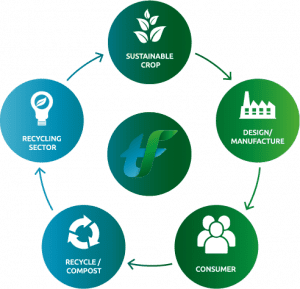End of Life Cycle in a Circular Economy
– A Sustainable Journey –

When it comes to sustainability, the End of Life Cycle of the product should be taken into consideration. The End of Life Cycle pertains to sustainability of the whole journey the item takes from the manufacture of its constituent materials to its use and its end of life.
In theory, most plastics may be recycled after use as long as they are separated at a recycler and there is a market for that recycled grade of plastic. In reality, most plastic ends up in a landfill and never makes the circular journey to being recycled or reused. A molded fiber item will have an entirely different journey. Derived from sustainable crops, fiber items can be recycled or composted. It will most likely become part of the circular economy as opposed to the linear economy. According to the Ellen Macarthur Foundation, we need to rethink the way we make packaging. Click here to learn more, https://www.ellenmacarthurfoundation.org/circular-economy/concept
The demand for molded pulp fiber products and packaging is increasing primarily because of its sustainable qualities. Molded pulp is a renewable material, it is biodegradable and compostable.
How can we predict the likely outcomes of both materials?
Globally, paper and pulp is much more widely recycled than plastic. The rates of recycling paper globally are over 65%. Countries that either have a robust recycling system (European) or have a fiber shortage (Middle and Far East) are averaging over 80%. The difference lies in the rates of recycling plastic (apart from PET bottles) are less than 8% globally.
One of the major reasons the above numbers are in favor of paper/pulp is that paper is much easier to recycle. One can process mixed paper into new fiber with ease; something that is not possible with plastic; where is each type of plastic has to be sorted and segregated to be recycled.
Newsprint or corrugated medium can contain fiber that came from many different sources such as office waste, newspaper, pulp packaging, cardboard boxes to name a few, something that is not possible with a cross section of household or hospital plastic waste.

According to the Sustainable Packaging Coalition, the definition of sustainable packaging has a series of criteria to follow in order to be sustainable. https://sustainablepackaging.org/wp-content/uploads/2019/06/Definition-of-Sustainable-Packaging.pdf
Thermoformed molded pulp satisfies the criteria if manufactured using best practices. Therefore, pulp packaging can be considered closed loop material and a sustainable packaging system.